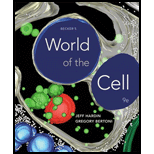
Becker's World of the Cell (9th Edition)
9th Edition
ISBN: 9780321934925
Author: Jeff Hardin, Gregory Paul Bertoni
Publisher: PEARSON
expand_more
expand_more
format_list_bulleted
Concept explainers
Textbook Question
Chapter 5, Problem 5.5PS
Violating the Second Law? The second law of
Expert Solution & Answer
Want to see the full answer?
Check out a sample textbook solution
Students have asked these similar questions
Answer for the number 7 question, Thank you. No need for long explanation.
Answer for the number 3 question, Thank you.
Help with the following question.
Chapter 5 Solutions
Becker's World of the Cell (9th Edition)
Ch. 5 - How do phototrophs and chemotrophs depend...Ch. 5 - How does the spontaneity of a chemical reaction...Ch. 5 - QUESTION: Why does the height of the spike get...Ch. 5 - For a chemical reaction happening in a cell, what...Ch. 5 - Prob. 5.1PSCh. 5 - QUANTITATIVE Photosynthetic Energy Transduction....Ch. 5 - Energy Conversion. Most cellular activities...Ch. 5 - Problem Set Enthalpy, Entropy, and Free Energy....Ch. 5 - Violating the Second Law? The second law of...Ch. 5 - QUANTITATIVE The Equilibrium Constant. The...
Knowledge Booster
Learn more about
Need a deep-dive on the concept behind this application? Look no further. Learn more about this topic, biology and related others by exploring similar questions and additional content below.Similar questions
- Matcharrow_forwardThe number 2 question. Thank youarrow_forwardBIOMOLECULES - MULTIPLE CHOICE - Please answer properly QUESTION : Which of the following best describes the transition state of a catalyzed reaction? A. higher in energy than that of an uncatalyzed reaction B. lower in energy than that of an uncatalyzed reaction C. bound very weakly to the catalyst D. lower energy than the reaction substratearrow_forward
- Why is it not enough to just rely on either thermodynamic data alone ... Or kinetic (rate of reaction) data alone to predict the possible occurrence of a chemical reaction?arrow_forwardurgenttttttarrow_forwardHandwrite everything in the picture The first law of thermodynamics, AU= q - w (2) where AU = internal energy change for system q = energy transfer into system by heat flow -W = work done by system may be applied to the actual Calorimeter process, which is assumed to be adiabatic (q = 0). In the present experiment, w, which consists mainly of the work of stirring, can be neglected' and Eq. (2) then becomes AUc = 0 (3) Since the energy Change is independent of path, one has AU = AU + J Co CdT (4) Since the temperature change is small, it is usually valid to consider C to be constant, so that the integral becomes equal to C(T2 - T1). One then obtains AUT1= -C(T2 - T1) (5) It may be observed that a temperature rise corresponds to a negative AUT1, that is, to a decrease in energy for the imagined isothermal process. The next step is to calculate AU,° from AUT1. Although the energy is not sensitive to changes in pressure, the correction to standard states, called the Washburn correction,…arrow_forward
- Knowing that liquid liquid phase separation will occur when the change of gibbs free energy of the system is negative and the gibbs free energy is contributed of enthalpy and entropy. Please states all the conditions (maybe like increasing/decreasing the concentration of that molecules? etc.) in biological system that induce liquid liquid phase separation.arrow_forwardNeed help with question number 2arrow_forwardNaCl (s) -> NaCI (aq) is accompanied by an increase in entropy because [Select] [Select] a solute was dissolved in water, forming a solution the number of products is greater than the number of reactants the phase change from vaporization is towards a higher internal energyarrow_forward
- uce the observations about each chemical reaction in the table below to decide the sign (positive or negative) of the reaction enthalpy AH and reaction entropy Note: if you have not been given enough information to decide a sign, select the "unknown" option. reaction observations conclusions The reverse of this reaction is always spontaneous but proceeds slower at temperatures below 132. °C. AH is (pick one) AS is (pick one) His (pick one) B This reaction is endothermic. AS is (pick one) This reaction is spontaneous except below 110. °C but proceeds at a slower rate below 135. °C. AH IS (pick one) AS is (pick one)varrow_forward3.4 INSTRUCTIONS — Do not copy in Google or Bartleby. Plagarize Checker will be usedarrow_forwardI need the answer as soon as possiblearrow_forward
arrow_back_ios
SEE MORE QUESTIONS
arrow_forward_ios
Recommended textbooks for you
 Biology (MindTap Course List)BiologyISBN:9781337392938Author:Eldra Solomon, Charles Martin, Diana W. Martin, Linda R. BergPublisher:Cengage Learning
Biology (MindTap Course List)BiologyISBN:9781337392938Author:Eldra Solomon, Charles Martin, Diana W. Martin, Linda R. BergPublisher:Cengage Learning Biology 2eBiologyISBN:9781947172517Author:Matthew Douglas, Jung Choi, Mary Ann ClarkPublisher:OpenStax
Biology 2eBiologyISBN:9781947172517Author:Matthew Douglas, Jung Choi, Mary Ann ClarkPublisher:OpenStax

Biology (MindTap Course List)
Biology
ISBN:9781337392938
Author:Eldra Solomon, Charles Martin, Diana W. Martin, Linda R. Berg
Publisher:Cengage Learning

Biology 2e
Biology
ISBN:9781947172517
Author:Matthew Douglas, Jung Choi, Mary Ann Clark
Publisher:OpenStax
Enzyme Kinetics; Author: MIT OpenCourseWare;https://www.youtube.com/watch?v=FXWZr3mscUo;License: Standard Youtube License